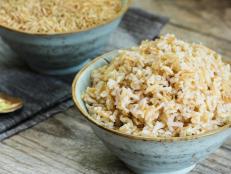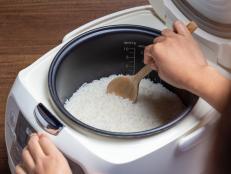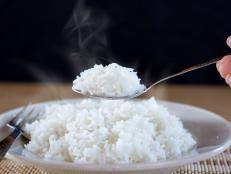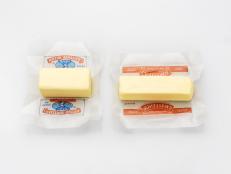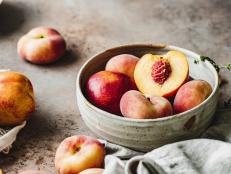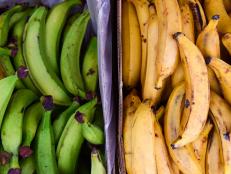What’s the Difference Between Basmati and Jasmine Rice?
They’re both types of long grain white rice. And they both need to be rinsed. But there the similarities end.

Nipol Plobmuang / EyeEm/Getty Images
By Layla Khoury-Hanold for Food Network Kitchen
Layla Khoury-Hanold is a contributor at Food Network.
At first glance, basmati rice and jasmine rice look the same. While they’re both varieties of long-grain white rice, they’re very different ingredients. For more insight, we turned to Chitra Agrawal, founder of Brooklyn Delhi, a small-batch Indian condiment company, and author of Vibrant India: Fresh Vegetarian Recipes from Bangalore to Brooklyn, and Amanda Maneesilasan, the Los Angeles-based chef-owner of Chao Krung Thai and partner in Tuk Tuk Thai and Pad Thai Diva.

Roberto Machado Noa/Getty Images
What Is Basmati Rice?
Basmati rice is a North Indian variety of rice grown in the foothills of the Himalayas that has nutty and floral flavors. Agrawal reports that the best quality basmati rice has a very long grain that is slightly tapered at the end. It should be golden in color rather than white, which shows it has been aged. The rice is aged to dry it completely for optimal cooking.
Basmati rice can be cooked in a variety of ways, including boiled or steamed. Agrawal grew up eating steamed basmati rice. “My parents used a double-boiler method, which prevents any burning or rice sticking to the bottom of the pan,” she says. “Some families cook their basmati rice right in the pot and cook off all of the water, while others may cook their rice like pasta and drain the water off.”
Well prepared basmati rice is fluffy, with grains that stay separate when cooked. As a result, Agrawal notes that basmati rice granules are easily coated and are most often served with a curry or dal. It is also used to prepare pilau and biryani, which is served with yogurt raita.

FotografiaBasica/Getty Images
What Is Jasmine Rice?
Jasmine rice is an aromatic, long-grain rice that is widely used in Southeast Asian cooking. “Thai people consume rice every day, maybe even three times a day,” Maneesilasan says. “It is our staple, and it's eaten with almost every main dish in Thailand.” During the cooking process, jasmine rice produces what she describes as a leafy, plant-like aroma. “Some people also compare the smell to buttered popcorn, but for people from Thailand, it smells like pandan.” Pandan is a tropical plant whose leaves have a soft, sweet aroma.
Jasmine rice is steamed to achieve its signature texture. “Well-prepared Jasmine rice maintains the individual grains and is slightly chewy, ever so slightly sticky, and, of course, fluffy and soft,” Maneesilasan says. She says that jasmine rice is commonly eaten with curries or traditional wok dishes like grapow, or in rice-based dishes such as fried rice and biryani chicken rice. “Some of the traditional dishes that we eat at home, like nam prik (chili paste dip), must be eaten with rice to get the full flavor of the chili mixed with rice with a side of egg and veggies,” she adds.
Basmati vs. Jasmine Rice: What’s the Difference?
Both basmati and jasmine rice are varieties of long-grain, white rice that require rinsing before cooking. But they each have a different structure that informs how they are cooked.
How they’re cooked: Basmati rice is hardier and needs to be soaked for at least 30 minutes, then typically boiled (although it’s often steamed too). Jasmine rice is steamed after rinsing, and since it is a softer variety of long-grain rice, it doesn’t require soaking and also requires less water— Maneesilasan recommends a ratio of 1 cup rice to 1 1/4 cups water.
Their texture and flavor: Basmati and jasmine rice also have a different texture, aroma and flavor when cooked. “Jasmine is moist and soft in texture when cooked, with a slightly sweet flavor. The grains cling and are somewhat sticky when cooked. During cooking, it produces a leafy, plant-like smell,” Maneesilasan says. “Basmati rice has a nutty flavor with a floral aroma. The smell of basmati rice is lighter and less noticeable.”
However, they can be used interchangeably: Despite these differences, jasmine and basmati rice can often be used interchangeably. “We have a dish called Chicken Biryani Rice that would be perfect with basmati rice because it's an Indian inspired dish, but at Chao Krung, we use jasmine rice with the dish. I feel that both [types of] rice can be substituted for each other with either cuisine.”
How to Cook Rice: A Step-by-Step Guide
Get perfect rice every time with these instructions for the classic method, the pasta method, the pilaf method and more.
Tips for Cooking Basmati Rice
Buying: Start with quality rice—look for long grains that are slightly tapered at the end and for ones that are golden in color, a sign that the rice has been properly aged and dried for optimal cooking results. Her favorite brand is Dehraduni basmati rice from the brand SWAD.
Prepping: To ensure that grains of basmati rice cook evenly, Agrawal recommends washing your rice thoroughly several times until the water runs clear and soaking it for at least 30 minutes. Agrawal washes the rice in the pot she plans to cook it in to save dishes, and because it’s easier to tell if the water is running clear than it is rinsing it in a sieve.
Cooking: While some families boil the rice like pasta and then pour out the remaining water, other households steam the rice. Her parents prefer a double-boiler method, which helps the rice to avoid burning or sticking while cooking.
Common Ways to Use Basmati Rice
Basmati rice is commonly used in Indian, Middle Eastern and Persian cooking, either as an accompaniment to soups, stews, vegetable dishes and proteins, or as the base for layered rice dishes, such as biryani and pilau. Below are some of our best basmati rice recipes.
Thoroughly rinsing rice is the only prep time required for making a batch of fluffy basmati rice. Don’t skip the salt—it’ll add just the right amount of seasoning.

This easy side dish is inspired by sweet and savory Indian pulaos. It features basmati rice that’s seasoned with garam masala and studded with dried fruits and nuts. Pro tip: wrapping the lid with a dish towel keeps the steam in the pot, encourages the rice grains to stay separate, and absorbs condensation that would otherwise collect on the lid and drip back into the pan.

This classic Iranian dish, also known as morasa polow or javaher polow, is a celebration dish that’s typically served at weddings and large gatherings. Every ingredient is prepared and cooked with care, then assembled on a bed of tender and fluffy saffron infused basmati rice.
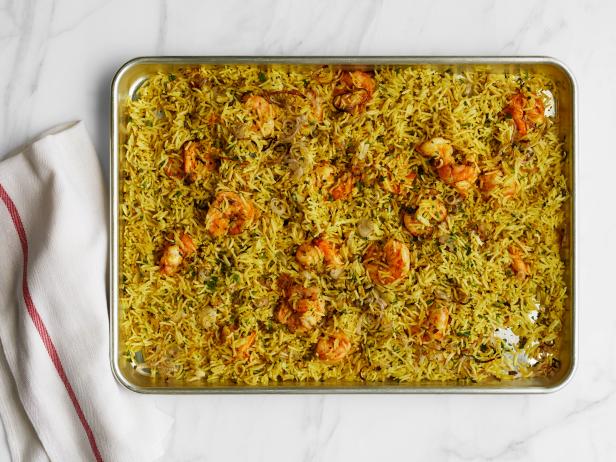
Bobbi Lin
This streamlined version of the classic Indian layered rice dish employs the sheet pan method, but still leans on garam masala and curry powder for its warming spice profile. Serve with fresh herbs, yogurt and cashews for added texture and flavor.

Teri Lyn Fisher
This one pan dinner features a duo of basmati rice and chickpeas, which absorb the heady flavors of ginger, garlic, curry powder and coconut milk as it bakes. Finish with a drizzle of yogurt, a sprinkling of cilantro leaves and a squeeze of fresh lime juice.
Tips for Cooking Jasmine Rice
Buying: For the most fragrant grains, start with 100 percent Jasmine rice grown in Thailand. Maneesilasan uses the brands Buddha or Three Ladies, because it's grown in Thailand and contains 100 percent jasmine rice. “The most fragrant grains are generally derived from Thailand because the food is indigenous to the region,” she says. Be sure to check the product’s packaging date to ensure that grains are at peak freshness. “Although the grains are packaged when fresh, the rice tends to lose its fragrance over the course of a few months. If you do not plan on cooking with the grains regularly, you should steer clear of bulk packages because the rice might lose its fragrance altogether,” she says.
Cooking: Finally, Maneesilasan shares her ideal formula: “When we cook at home, we normally use a rice cooker, 2 cups of rice, rinse once or twice, and add 1 1/2 cups of water.”
Common Ways to Use Jasmine Rice
Jasmine rice can be served as a side, either plain steamed rice to accompany curries, like this Thai Green Curry with Shrimp, or infused with other flavors or herbs. Jasmine rice is also used to make rice-based dishes such as pilaf or fried rice. Here are some of our best jasmine rice recipes.

Tara Donne
For an easy, flavorful side, cook shallots, cumin and salt, add jasmine rice and stir to coat the grains, then simmer till tender in broth seasoned with orange zest and a cinnamon stick. A sprinkling of cashews and scallions finishes the dish.
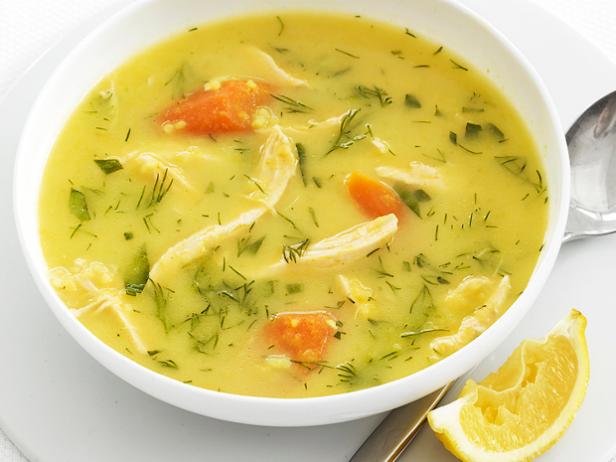
In this comfort food spin, jasmine rice is simmered in an aromatic broth spiked with Madras curry powder and sauteed onion. Once the rice is fall-apart tender, the mixture is pureed with an immersion blender till smooth to make a hearty, satisfying base.

You could serve plain steamed rice with this dish, or you could up the ante with this simple flavor boost. Jasmine rice is simmered with a mixture of coconut milk, rice, lemongrass (or ginger) until the liquid is absorbed and the rice is tender.

Caitlin Ochs
Cooked and cooled jasmine rice is used to anchor one of our fan-favorite fried rice dishes—all the more reason to make a big batch of rice the day before. It retains its structure and is the perfect counterpoint to sweet, slightly smoky Cantonese-style BBQ pork fried rice.

RYAN DAUSCH
Delicate jasmine rice is infused with grated fresh ginger, cucumber and mint, offering a bright, herbaceous contrast to the aromatic flavors of the porkchop’s sweet-savory lemongrass marinade.
Related Links:
























